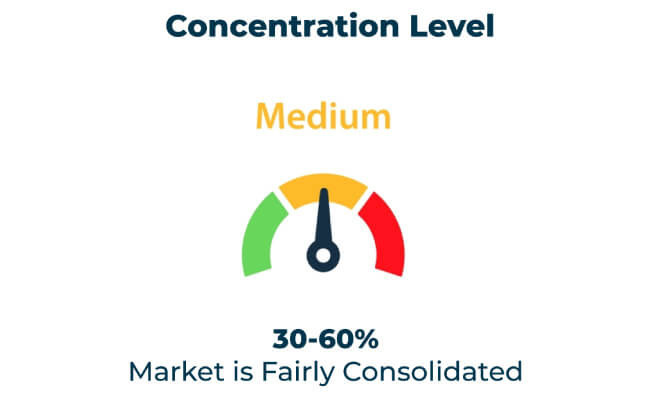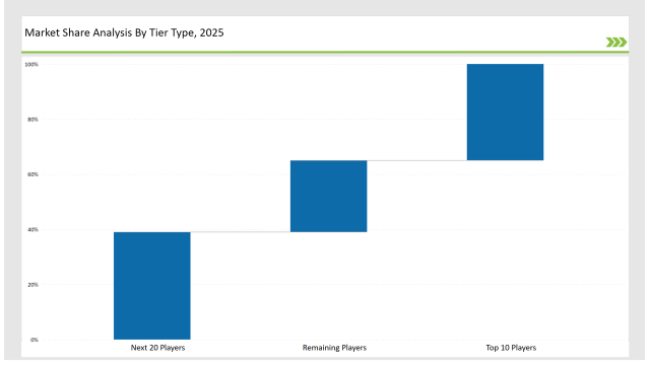Sustainability, fashion, and functionality are the three pillars driving the growth potential of the tote bag market, which is thus witnessing huge demand. The perceptive consumers are abandoning plastic bags, opting to use their shopping, travel, and everyday tote bags made of preferably reusable and sturdy materials combining style.
Brands are taking active steps in eco-friendly substance use, customizing, designing stylish products to accommodate evolving consumer traits and regulatory mandates on plastic reduction.
Manufacturers are coming up with a range of tote bags sourced from organic cotton, recycled fabric, jute, and biodegradable substances in sync with the sustainability trends. Companies are engaging in digital printing, smart tracking, and foldable designs to enhance utility and branding potential. The industry is moving toward lightweight, functional, and high-fashion tote bags to fulfill consumer needs across different demographics.
35% of the market is shared by Tier-1 players like Baggu, Fjällräven, and L.L. Bean due to premium product offerings, sustainable actions, and strong brand recognition.
Tier-2 companies, including Herschel Supply Co., Everlane, and Patagonia, make up 39% of the market by providing fashionable, durable, and ethically sourced tote bags for urban and outdoor consumers.
Tier-3 constitutes regional and niche players that deal with custom printed tote bags and artisanal designs as well as cost-effective alternatives, occupying 26% of the market. These companies focus on local production, building personalized branding, and working toward eco-friendly innovations.
Global Market Share by Key Players (2025)
| Category | Market Share (%) |
|---|---|
| Top 3 (Baggu, Fjällräven, L.L. Bean) | 17% |
| Rest of Top 5 (Herschel Supply Co., Everlane) | 10% |
| Next 5 of Top 10 (Patagonia, Madewell, Rothco, Freitag, Blue Q) | 8% |

The tote bag industry serves multiple sectors where sustainability, fashion, and convenience are key drivers. Companies are designing versatile tote bags that cater to consumer lifestyle demands and sustainability goals.
Manufacturers are optimizing tote bag production with high-quality materials, unique designs, and sustainable innovations.
The environment and convenience for consumers are changing the tote bag industry. New production techniques include the application of digital printing, innovative fabric blends, and more storage designs for accessibility and branding. Companies are producing water-resistant, light tote bags for urban use and travel. Manufacturers are building collapsible bags with multiple pockets for enhanced utility. The brands have also started to pursue limited artist collaborations to appear more fashionable.
Year-on-Year Leaders
Technology suppliers should focus on automation, sustainable materials, and digital customization to support the evolving tote bag market. Partnering with fashion brands, retailers, and eco-conscious companies will drive adoption.
| Tier Type | Example of Key Players |
|---|---|
| Tier 1 | Baggu, Fjällräven, L.L. Bean |
| Tier 2 | Herschel Supply Co., Everlane, Patagonia |
| Tier 3 | Madewell, Rothco, Freitag, Blue Q |

Leading manufacturers are advancing tote bag technology with sustainable materials, innovative designs, and customization capabilities.
| Manufacturer | Latest Developments |
|---|---|
| Baggu | Launched recycled nylon tote bags in March 2024. |
| Fjällräven | Developed water-resistant G-1000 fabric totes in April 2024. |
| L.L. Bean | Expanded heavyweight canvas tote collections in May 2024. |
| Herschel Supply | Released packable commuter-friendly tote bags in June 2024. |
| Everlane | Strengthened recycled cotton tote bag production in July 2024. |
| Patagonia | Introduced Fair Trade Certified™ upcycled tote bags in August 2024. |
| Madewell | Pioneered limited-edition artist collaborations in September 2024. |
The tote bag market is evolving as companies invest in sustainable materials, customizable designs, and high-performance fabrics.
The industry will further integrate design driven by AI, sustainable materials, and compact storage features. Manufacturers will refine blends of lightweight yet durable fabrics to improve a bag's life. Firms will expand customization through digital printing. Companies will introduce fully biodegradable tote bags to accord with eco-conscious consumers. Digital authentication will create a more formidable brand protection and exclusivity. Besides, businesses will move to scale production efficiency through automated sewing and cutting techniques.
By material, the market is segmented into canvas, cotton, jute, leather, and other materials.
The market is segmented into printed, solid, and textured based on the pattern type.
Based on the distribution, the market is bifurcated into online and offline.
Based on the region, the market is segmented into North America, Latin America, Europe, South Asia, East Asia, Middle East & Africa, and Oceania.
Leading players include Baggu, Fjällräven, L.L. Bean, Herschel Supply Co., Everlane, Patagonia, and Madewell.
The top 3 players collectively control 17% of the global market.
The market shows medium concentration, with top players holding 35%.
Key drivers include sustainability, digital customization, multi-functionality, and lightweight design.






Our Research Products

The "Full Research Suite" delivers actionable market intel, deep dives on markets or technologies, so clients act faster, cut risk, and unlock growth.

The Leaderboard benchmarks and ranks top vendors, classifying them as Established Leaders, Leading Challengers, or Disruptors & Challengers.

Locates where complements amplify value and substitutes erode it, forecasting net impact by horizon

We deliver granular, decision-grade intel: market sizing, 5-year forecasts, pricing, adoption, usage, revenue, and operational KPIs—plus competitor tracking, regulation, and value chains—across 60 countries broadly.

Spot the shifts before they hit your P&L. We track inflection points, adoption curves, pricing moves, and ecosystem plays to show where demand is heading, why it is changing, and what to do next across high-growth markets and disruptive tech

Real-time reads of user behavior. We track shifting priorities, perceptions of today’s and next-gen services, and provider experience, then pace how fast tech moves from trial to adoption, blending buyer, consumer, and channel inputs with social signals (#WhySwitch, #UX).

Partner with our analyst team to build a custom report designed around your business priorities. From analysing market trends to assessing competitors or crafting bespoke datasets, we tailor insights to your needs.
Supplier Intelligence
Discovery & Profiling
Capacity & Footprint
Performance & Risk
Compliance & Governance
Commercial Readiness
Who Supplies Whom
Scorecards & Shortlists
Playbooks & Docs
Category Intelligence
Definition & Scope
Demand & Use Cases
Cost Drivers
Market Structure
Supply Chain Map
Trade & Policy
Operating Norms
Deliverables
Buyer Intelligence
Account Basics
Spend & Scope
Procurement Model
Vendor Requirements
Terms & Policies
Entry Strategy
Pain Points & Triggers
Outputs
Pricing Analysis
Benchmarks
Trends
Should-Cost
Indexation
Landed Cost
Commercial Terms
Deliverables
Brand Analysis
Positioning & Value Prop
Share & Presence
Customer Evidence
Go-to-Market
Digital & Reputation
Compliance & Trust
KPIs & Gaps
Outputs
Full Research Suite comprises of:
Market outlook & trends analysis
Interviews & case studies
Strategic recommendations
Vendor profiles & capabilities analysis
5-year forecasts
8 regions and 60+ country-level data splits
Market segment data splits
12 months of continuous data updates
DELIVERED AS:
PDF EXCEL ONLINE
Tote Bag Market Growth, Trends, Forecast 2024-2034
Market Share Breakdown of the IV Bag Market
Market Share Breakdown of Bag-In-Box Manufacturers
Competitive Landscape of Bag-in-Tube Market Share
Tote And Ingredient Bags Packaging Market Size and Share Forecast Outlook 2025 to 2035
Competitive Overview of Wine Bag Companies
Understanding Market Share Trends in Mesh Bags
Competitive Landscape of Oven Bag Providers
Market Share Insights for Bagasse Bowls Providers
Competitive Breakdown of Silo Bag Manufacturers
Market Share Distribution Among Garbage Bag Companies
Market Share Insights of Bagging Machine Providers
Trash Bag Market Leaders & Competitive Insights
Market Share Breakdown of Craft Bags Manufacturers
Competitive Breakdown of Paper Bags Providers
Market Share Analysis of Jumbo Bags & Key Players
Understanding Market Share Trends in Bagasse Packaging
Competitive Breakdown of Bag Closure Clip Providers
Evaluating Slider Bags Market Share & Provider Insights
Key Companies & Market Share in the Silage Bags Sector

Thank you!
You will receive an email from our Business Development Manager. Please be sure to check your SPAM/JUNK folder too.
Chat With
MaRIA